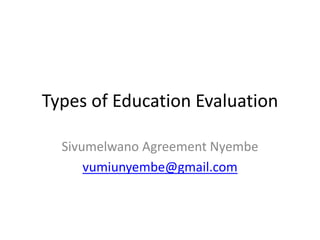
Types of Education Evaluation.pdf
- 1. Types of Education Evaluation Sivumelwano Agreement Nyembe vumiunyembe@gmail.com
- 2. Introduction • Evaluation is an essential process in various domains to assess the effectiveness, performance, or quality of something. • There are different types of evaluations depending on the context and the purpose they serve.
- 3. Defintion of evaluation • Evaluation is the process of assessing the value, worth, or quality of something. In education, evaluation refers to the systematic and ongoing assessment of student learning, progress, and performance in relation to set learning objectives and standards.
- 4. Importance of evaluation • It is always important to understand the progress of students to plan better further and work on their weaker areas. • Evaluations help to identify the areas of strengths and weaknesses of a student. • It helps to understand the potential of every student, which helps to curate a better learning plan for the students and helps them grow rapidly. • It is important for a teacher to understand the different types of evaluation in education processes and how they are used in a classroom.
- 5. The goal of evaluation • Is to provide teachers and students with information to improve learning outcomes and measure the effectiveness of teaching and learning practices. • Evaluation methods can include tests, quizzes, essays, projects, observations, and more. • Evaluation is an important aspect of the educational process as it helps teachers understand student learning and adjust their teaching practices accordingly.
- 6. Types of evaluation in education • A teacher should use different types of evaluation in education that are most suitable for their classroom • It is important for teachers to understand the different types of evaluation in education processes and how they can use them in their teaching.
- 7. Formative Evaluation • Formative evaluation refers to the assessment being conducted multiple times. • In the formative assessment process, teachers conduct tests after an interval of some time that makes them understand what the students have understood and what they can still learn. • Formative assessments are ongoing, classroom-based evaluations designed to provide feedback to both teachers and students. • Help to identify student strengths and weaknesses, track progress, and inform instructional adjustments.
- 8. Summative Assessment • Summative assessments are typically administered at the end of a learning period, such as a unit, semester, or school year. • Their primary purpose is to measure student achievement and determine if learning goals have been met. • This evaluation decides whether the students will go further into the next grade or will they have to repeat the same year again. • This assessment clubs the entire syllabus of the one exam and the evaluation of this results in deciding the future of the students. • The students get certifications at the completion of their summative evaluations – Certifications help students to go to the next level of their education – Formative assessments can help students to score better in summative evaluation.
- 9. Standardized Testing • Standardized tests are assessments with consistent formats, administration procedures, and scoring. • They are used to compare the performance of students within a region, country, or across nations. • A standardized test is any type of test in which all test takers must address the same questions or subset of questions from a shared pool. • Standardized testing creates a baseline for measuring student performance among districts, maintains teacher responsibility, and • They aids educators while developing their curriculum
- 10. Diagnostic Assessment • Diagnostic assessments are used to identify students' specific learning needs, skill gaps, or misconceptions. They help teachers tailor instruction to meet individual student requirements.
- 11. Criterion-Referenced Assessment • Criterion-referenced assessments measure how well a student has mastered specific learning objectives or criteria. The focus is on whether students meet predetermined standards, rather than comparing them to peers. •
- 12. Norm-Referenced Assessment • Norm-referenced assessments compare a student's performance to that of a group or normative sample. These tests help rank students relative to their peers.
- 13. Performance-Based Assessment • Performance-based assessments evaluate students' ability to apply knowledge and skills in real-world scenarios. They often involve projects, portfolios, or hands-on tasks.
- 14. Portfolio Assessment • Portfolio assessment involves collecting and evaluating samples of a student's work over time. It provides a comprehensive view of a student's progress, achievements, and areas for improvement.
- 15. Self-Assessment • Self-assessment encourages students to reflect on their learning, strengths, and weaknesses. It helps develop metacognitive skills and fosters a sense of ownership over the learning process.
- 16. Peer Assessment • Peer assessment involves students evaluating the work of their peers. It promotes collaboration, communication skills, and a deeper understanding of the subject matter.
- 17. Teacher Evaluation • Teacher evaluation is conducted to assess the effectiveness of educators in the classroom. It considers their instructional practices, classroom management, and contributions to student learning.
- 18. Program Evaluation • Program evaluation assesses the effectiveness of educational programs, interventions, or curriculum changes. It helps determine whether the program's objectives are being met and if any modifications are needed.
- 19. Institutional Evaluation • Institutional evaluations focus on the overall performance of an educational institution. It considers factors such as student outcomes, faculty qualifications, infrastructure, and resources.
- 20. Feedback and Observations • Regular feedback and classroom observations from administrators or peers can provide valuable insights into teaching practices and student engagement. • .
- 21. Conclusion • These various types of evaluations in education contribute to a comprehensive understanding of students' progress, teaching efficacy, and overall educational effectiveness. They play a crucial role in shaping education policies, curriculum development, and instructional practices